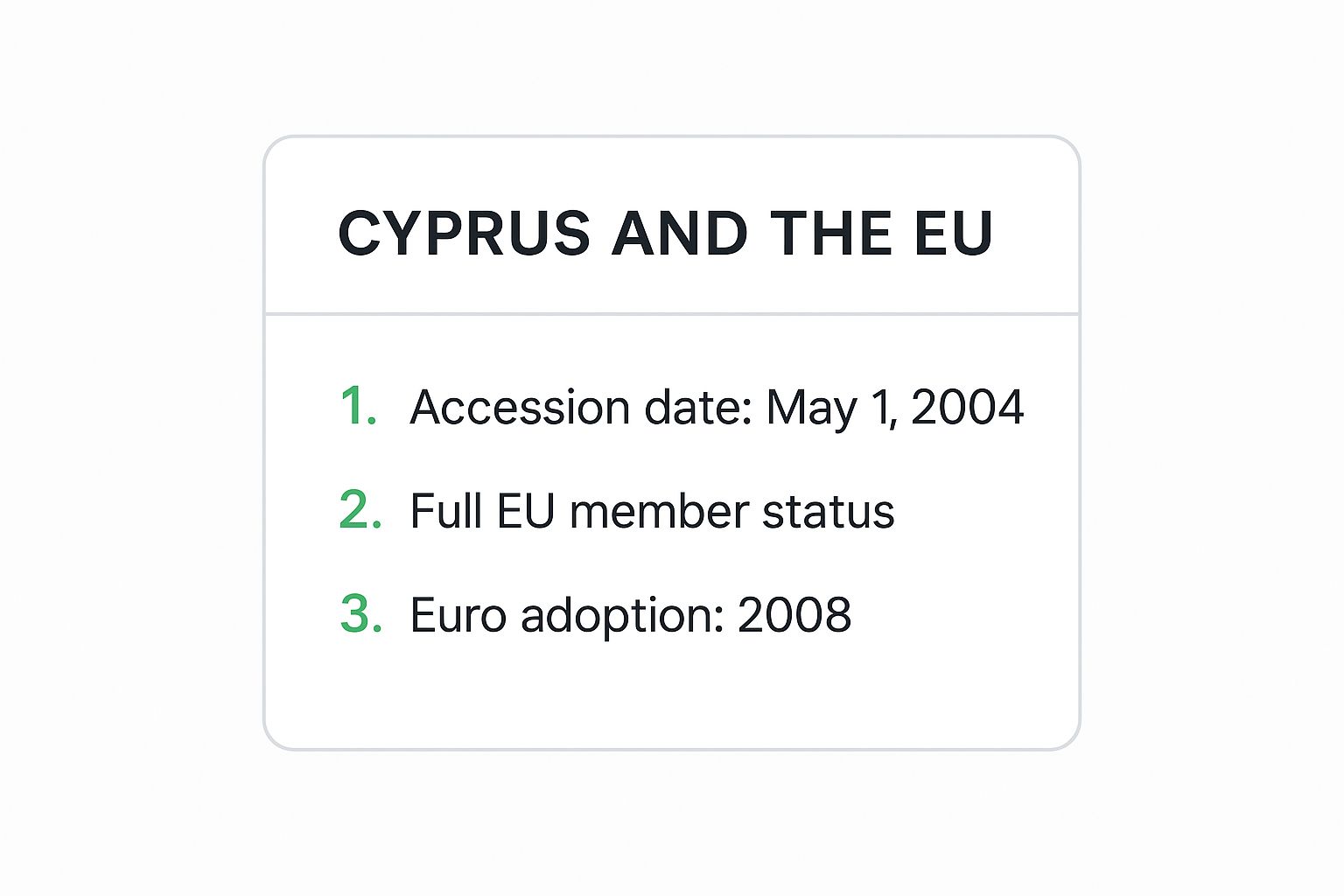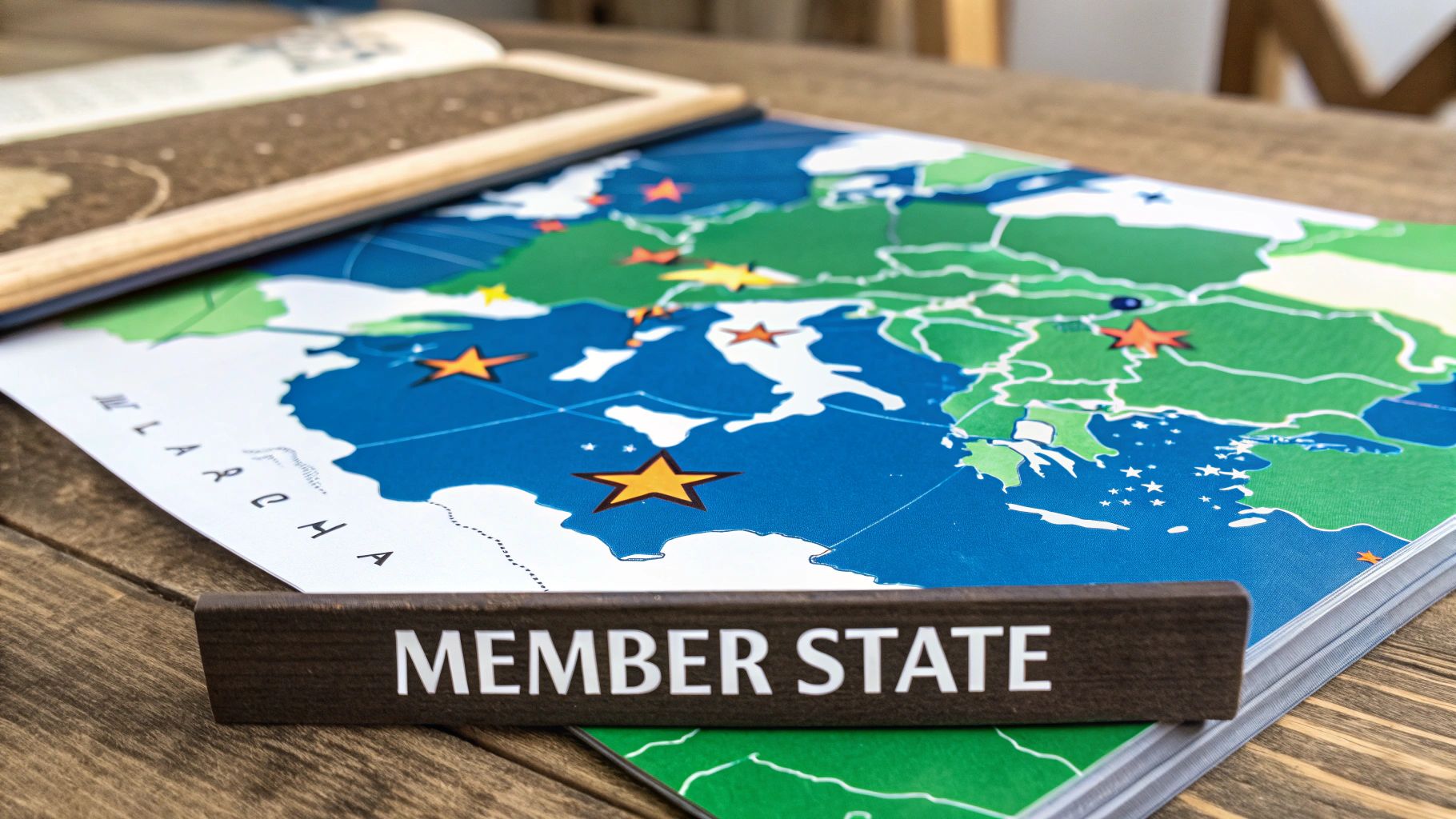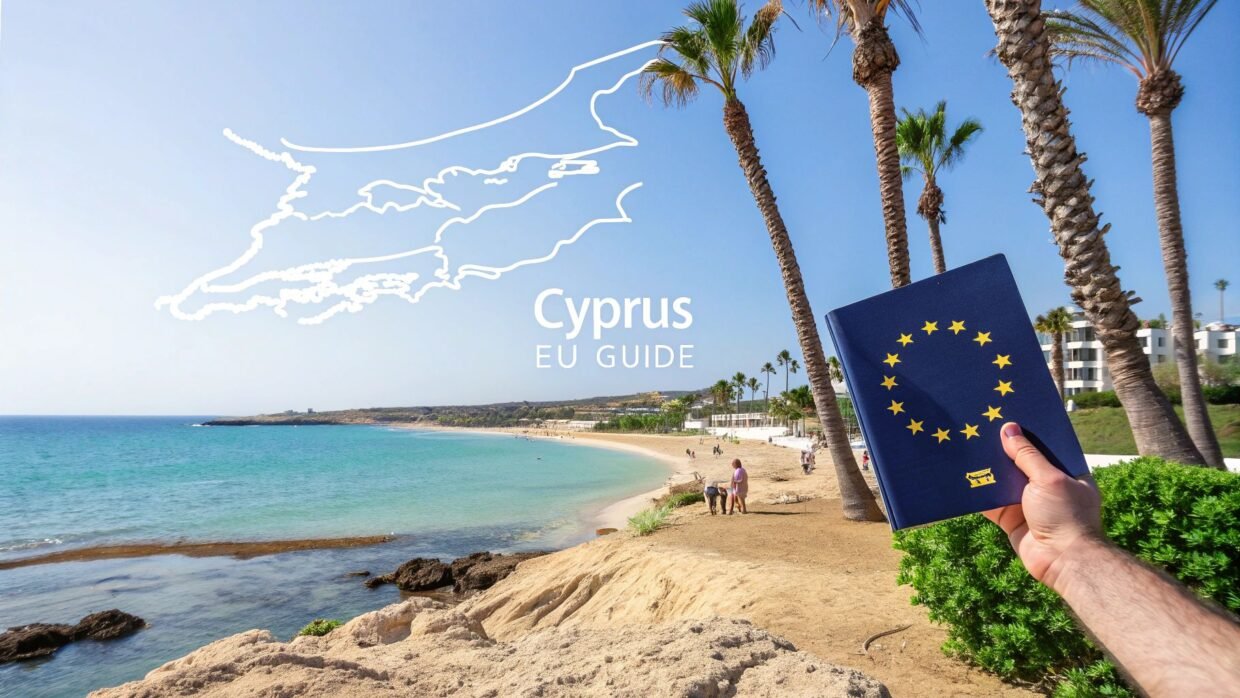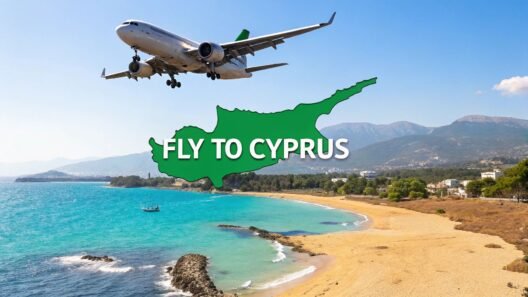So, let's cut right to the chase: is Cyprus in the European Union? The short answer is yes. The Republic of Cyprus is a full EU member state. But as with so many things on this beautiful Mediterranean island, the full story is a bit more complex.
Yes, Cyprus Is In The EU — But It's Complicated
The best way to think about Cyprus’s situation is to imagine you own a house, but a fence runs through the middle of your garden, and you can't access the other side. Legally, the whole property is yours, but practically, you can only use the part you can get to. That’s Cyprus and the EU in a nutshell.
On 1 May 2004, the Republic of Cyprus officially joined the European Union in a major expansion that brought in ten new countries. The key legal point here, outlined in Protocol 10 of the Accession Treaty, is that the entire island is considered EU territory. However, the application of EU law—the rights, rules, and benefits—is suspended in the northern part of Cyprus, which is not under the effective control of the Republic.
This visual gives a great overview of the key dates and facts about Cyprus’s journey into the EU.

As you can see, the integration went further when Cyprus adopted the Euro on 1 January 2008, embedding itself even deeper into the core of the European project.
To quickly summarise the situation on the ground for the Republic of Cyprus, this table breaks it down.
Cyprus EU Status At a Glance
| Framework | Status for Republic of Cyprus | Key Takeaway |
|---|---|---|
| EU Membership | Full Member since 2004 | The entire island is legally EU territory. |
| EU Law Application | Applies only in the south | EU benefits and regulations are suspended in the north. |
| Eurozone | Member since 2008 | The Euro (€) is the official currency in the south. |
| Schengen Area | Not yet a member | Border controls are still in place, even for EU arrivals. |
This distinction between the legal reality and the on-the-ground facts is crucial for anyone planning to visit, live, or do business on the island. It affects everything from which passport queue you use at the airport to what currency you’ll need in your wallet.
Throughout this guide, we'll unpack what this all means for you practically, so you can navigate Cyprus with confidence.
The Strategic Journey into the European Union

Cyprus’s path to the EU wasn't a snap decision. It was a long-held ambition, born from decades of complex history. The first formal step was an application back in 1990, just as the political map of Europe was being redrawn. For the Republic of Cyprus, this was about more than just economics; it was about finding an anchor in a turbulent region, promising security, stability, and a solid footing within the European family.
When serious talks finally got underway in 1998, a huge question loomed over the entire process: how could a divided island join the Union? This was uncharted territory for the EU, and Turkey's own EU ambitions at the time only added another layer of complexity.
A Landmark Decision
The EU was at a crossroads. Should it put Cyprus's application on hold until the long-stalled political situation was resolved, or should it find a way forward?
The breakthrough came at the Helsinki European Council meeting in 1999. It was here that EU leaders made a critical declaration: a political settlement on the island would not be a prerequisite for Cyprus joining. This was a pragmatic move that effectively separated the country's EU membership from the resolution of the Cyprus problem. You can dig deeper into this pivotal moment on The Hague Institute for Global Justice’s research portal.
This decision was the green light Cyprus had been waiting for. It meant the EU was willing to accept the reality on the ground and move ahead with integrating the internationally recognised Republic of Cyprus into its largest-ever expansion.
With that major hurdle cleared, the path was open for the historic 2004 enlargement. For Cyprus, joining the EU wasn't just a political milestone; it was the result of a long and determined journey that firmly cemented its place as a modern European state.
Navigating Borders And Travel To Cyprus

So, what does Cyprus's EU membership actually mean when you’re standing at the airport? If you're an EU citizen, travelling between member states is usually a breeze, often just needing a national ID. But with Cyprus, there's a crucial detail everyone needs to know: Cyprus is not yet part of the Schengen Area.
It helps to think of the Schengen Area as a special travel club within the EU. Countries in this club, like France and Italy, have dropped all internal border checks. That’s why you can fly from Paris to Rome without showing your passport. Since Cyprus hasn't joined this club, it maintains its own border controls for everyone. This means you will always need to present your passport or ID when arriving at Larnaca or Paphos, regardless of where you've come from.
Cyprus Travel Versus Schengen Travel
This non-Schengen status has some interesting quirks, especially for visitors from outside the EU, like those from the UK, USA, and Canada. To break it down, here’s a quick comparison of what to expect when travelling to Cyprus versus a Schengen country like its neighbour, Greece.
Cyprus vs Schengen Country Travel Rules
| Travel Aspect | Cyprus (EU, Non-Schengen) | Schengen Area Country (e.g., Greece) |
|---|---|---|
| Border Control | Passport/ID checks for all arrivals. | No internal border checks between member countries. |
| Visa Rules | Operates its own national visa policy. | A single Schengen visa grants access to all member states. |
| 90-Day Limit | Time spent here does not affect the Schengen limit. | Time spent here does count towards the 90/180-day limit. |
As you can see, that last point is a game-changer for anyone planning a longer trip around Europe.
The fact that Cyprus is in the EU but not Schengen creates a unique travel loophole. Your stay in Cyprus is governed by its own rules, completely separate from the 90 days you're allowed in the Schengen zone every 180 days.
What does this mean in practice? You can enjoy up to 90 days exploring Cyprus without using up any of your precious time allowance for Schengen countries like Spain, Italy, or Germany. It essentially lets you "pause" your Schengen clock while still soaking up the sun in an EU destination. This makes it an incredibly popular base for digital nomads and long-term travellers looking to maximise their time in Europe.
For the specific entry rules that apply to your nationality, it's always best to check the latest guidance. You can find a detailed breakdown in this helpful guide to getting a visa for Cyprus.
Understanding The Euro In The Cypriot Economy

On 1 January 2008, Cyprus took another huge step in its European journey by adopting the euro. This decision swapped the historic Cypriot Pound for the single European currency, cementing the nation's place at the heart of the EU's economic structure.
Think of joining the Eurozone as getting a key to an exclusive financial club. It brought a new level of economic stability and made life far easier for the millions of tourists and businesses crossing its borders, who could now forget about pesky exchange rates. Of course, membership also means playing by the strict economic rules laid down by the European Central Bank.
If you're curious about the old money, you can dive into the history of what currency Cyprus used before the euro in our detailed guide. This was more than just a symbolic change, though; it proved to be an essential lifeline.
A Test During The Financial Crisis
The real benefit of being in the Eurozone was thrown into sharp relief during the 2012–2013 financial crisis. With the Cypriot economy in serious trouble, its membership gave it access to crucial EU stability mechanisms and emergency funds that wouldn't have otherwise been available.
While it was an incredibly tough time for the country, its access to EU/IMF assistance programmes was directly tied to its Eurozone status. This support was vital for stabilising the banking sector and stopping a much deeper economic collapse, a path also taken by countries like Ireland, Greece, and Portugal.
In the aftermath of the crisis, Cyprus launched into a period of serious economic reform. This difficult process brought real, tangible benefits that have strengthened the nation's economy for the long haul:
- Restored Stability: It helped bring back much-needed confidence in the country's financial system.
- Reduced Debt: Government debt has fallen steadily, with Cyprus now performing better than many other euro area nations.
- Improved Competitiveness: The economy was restructured, helping to make it more competitive on the world stage.
This shows how the currency you spend on holiday is deeply connected to the country's powerful link with Europe's wider economic framework. It's a fundamental part of the answer to the question, "is Cyprus in the EU?".
The Green Line: A Unique European Border
This is where the story of Cyprus's EU membership gets really interesting. The island is physically split by a United Nations-controlled buffer zone called the Green Line, which separates the Republic of Cyprus in the south from the northern part of the island.
Legally speaking, the entire island is considered EU territory. But on the ground, that's more of a technicality. The full body of EU law, known as the acquis communautaire, is currently suspended in the north. This creates a fascinating and complex situation you won’t find anywhere else in the Union.
What Suspension of EU Law Means
Think of the Green Line as a sort of internal EU border where the rules suddenly change. All the rights and regulations that come with being in the EU—like the free movement of goods and services, for example—don't apply in the north.
This has very real consequences for anyone moving between the two sides. The Republic of Cyprus, with oversight from the EU, manages the regulations for crossing this line, both for people and for goods.
Legally, when you cross from south to north, you are leaving the area where EU law is enforced, even though you haven't technically left EU territory. This distinction affects everything from customs allowances to legal jurisdiction.
For instance, goods made in the north don't automatically get the same access to the EU single market as products from the south. There are special arrangements under the EU's Green Line Regulation to manage this trade, but it's still quite limited. To get a better handle on the island's unique geography, you can explore this detailed guide on where Cyprus is located.
For travellers, the good news is that crossing at designated checkpoints is usually straightforward. Still, it's smart to know the rules before you go:
- Documentation: You’ll need to show your passport or a national ID card to officials on both sides of the crossing.
- Goods: Be aware of the limits. There are restrictions on the value and quantity of things like tobacco and alcohol that you can bring back into the south.
- Insurance: Your car insurance from the south probably won't cover you in the north. You’ll almost certainly need to buy separate insurance cover at the border.
Getting your head around this unique border is the key to truly understanding the full picture of Cyprus's fascinating place within the European Union.
It’s easy to get tangled up in the details of Cyprus’s unique situation. Being in the EU but not quite in Schengen, coupled with the island’s division, naturally brings up a lot of practical questions for travellers.
Let's cut through the confusion and get straight to what you need to know.
Your Most Common Questions Answered
We’ve pulled together the questions we hear most often from visitors, offering clear, simple answers to help you plan your trip.
Does my visit to Cyprus count towards my 90-day Schengen limit?
No, it doesn't. Since Cyprus isn't part of the border-free Schengen Area, any time you spend here is completely separate from your 90/180-day allowance for the Schengen zone. This is a real bonus for non-EU citizens (like UK visitors) who want to spend more time in Europe without 'eating into' their Schengen days.
Can I use Euros in Northern Cyprus?
Yes and no. The official currency in the north is the Turkish Lira (TRY), but you'll find that Euros are widely accepted in tourist areas, from shops to restaurants. Just be prepared for your change to be given back in Lira. It's always a good idea to have some Lira on hand for smaller buys or if you venture off the beaten path.
Is it legal to cross the Green Line to Northern Cyprus?
Absolutely. It's perfectly legal for EU and non-EU citizens to cross the Green Line at any of the official checkpoints. You'll just need to show your passport to the officials on both sides. Keep in mind that goods bought in the north, particularly things like tobacco and alcohol, are subject to customs limits when you cross back into the Republic of Cyprus.
A word of warning for the connected traveller: your EU mobile roaming plan won't work in the north. The "Roam Like at Home" rules only apply within the Republic of Cyprus. The moment you cross the Green Line, your phone will latch onto a Turkish network, and you could face steep international roaming fees. We strongly advise turning off your mobile data before you cross to avoid a nasty surprise on your next bill.
This one simple step can save you a serious amount of money and stress while you explore the northern part of the island.
At SayCyprus, our passion is helping you uncover every gem this incredible island has to offer. From sun-drenched beaches to quiet mountain villages, our guides are packed with the kind of insider knowledge you need to experience Cyprus like a true local. Find out more at SayCyprus.com.












